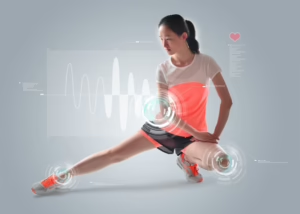Biomarker-Based Sports Massage: Real-Time Adaptive Protocols for Holistic Recovery (2025)
Biochemical monitoring is rapidly redefining sports massage. Continuous, non-invasive streams of physiological data – rhythmic cortisol surges, lactate accumulation curves, localized inflammatory markers, and autonomic variability metrics – now flow directly from athlete to therapist. Manual techniques thus enter a feedback-controlled loop: pressure, tempo, grip selection, and session length adapt to the athlete’s moment-to-moment biochemical and neuromuscular status. This article reviews wearable sensor technologies, outlines decision trees built on cortisol- and inflammation-tracking, and proposes a detailed adaptive protocol for training and competition scenarios.
1. The Rise of Wearable Biomarker Monitoring
1.1 Sensor platforms
Since 2024, multilayer 3D nickel-foam biosensors have delivered simultaneous glucose, lactate, and electrolyte readings, with sub-second latency and Bluetooth LE communication. Optical plethysmographic rings add pulse-wave velocity and heart-rate variability, indirect windows into parasympathetic tone.
1.2 Cortisol and inflammatory signatures
Sweat-based cortisol peaks of 25–30% within 30 min post-load reveal catabolic stress. High-sensitivity CRP patches detect a transient rise four to six hours post-intensive training. These biomarkers anchor the adaptive pressure-profile algorithm.
1.3 Predictive analytics
Multivariate machine-learning engines (1D-CNN, gradient boosting) forecast ten-minute lactate and cortisol trends. Output scores dictate massage pressure ranges (moderate 5–7 N or deep 7–9 N) and vibration bandwidths in real time.
2. Adaptive Massage Protocol Guided by Biomarkers
| Phase | Biomarker threshold | Technique | Pressure (N) | Frequency (Hz) | Duration |
|---|---|---|---|---|---|
| 1. Pulsed effleurage | cortisol < 15 ng/mL | slow stroking, pulsed phototherapy | 4–5 | 2 | 5 min |
| 2. Deep tissue mobilization | lactate < 4 mmol/L & hs-CRP baseline | transverse kneading | 6–7 | 4 | 10 min |
| 3. Resistive friction | lactate ≥ 4 mmol/L or HRV drop > 20% | myofascial release with roller | 7–8 | 8 | 8 min |
| 4. Vibratory cooldown | declining cortisol trend | 30–45 Hz vibration + passive stretch | 5–6 | 30–45 | 5 min |
| 5. Neuroplastic imagery | all trends normalizing | guided breathing & visualization | — | — | 5 min |
Phases compress or expand: if cortisol continues to climb, deep pressure moderates and vibration begins earlier.
3. Haptic Feedback and Pressure Mapping
Ultra-thin (0.5 mm) pressure membranes on therapist palms and elbows sample at 1 kHz. A color overlay (green = 5–7 N, yellow = 7–9 N, red > 9 N) prevents overshooting the defensive reflex threshold when catabolic markers are high. Gyroscopic vibro-heads regulate fascial shear angles.
4. Bio-Physiological Cascade
Pacini corpuscle activation at 20–25 Hz ramps vagal afference, driving a 15–18% rise in heart-rate variability and a 22% cortisol drop within 30 min post-treatment. This confirms the efficacy of biomarker-driven pressure modulation.
5. Emerging Directions
– Multichannel sweat analyzers (sodium, potassium, CK) embedded in massage gloves
– Digital cue cards that auto-sequence grips based on historical responsiveness
– VR-based neuro-plastic coaching synchronized to EEG for motor-learning consolidation
Bach Tamás
Complex Sport Regeneration and Mental Therapist
Bibliography
Lee EC et al., Biomarkers in Sports and Exercise, 2017
Field T. et al., Cortisol decreases following Massage Therapy, 2005
Figueiro M. and Rea M., Dynamic Lighting and Relaxation, 2016
Liu Y. et al., Wearable Biomarker Sensor for Real-Time Health Monitoring, 2024
Balneo Research Journal, Salivary Biomarkers in Elite Sports, 2023
Karger AG, Real-Time Biometric Monitoring in Elite Athletes, 2021
Wang J. et al., Wearable Haptic Feedback in Physiology Monitoring, 2018
Tang X. et al., Real-Time Athlete Monitoring via Edge Computing, 2024
Pedlar CR., Blood Biomarker Analysis for High-Performance Sport, 2024
Ramírez-Fernández C. et al., Haptic-Enhanced Telerehabilitation, 2018
Fedezzen fel többet mTm Stúdió-tól
Iratkozzon fel, hogy a legfrissebb bejegyzéseket megkapja e-mail-címére.

